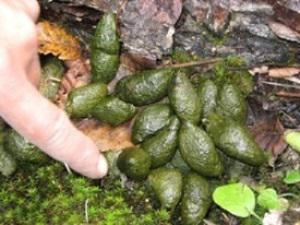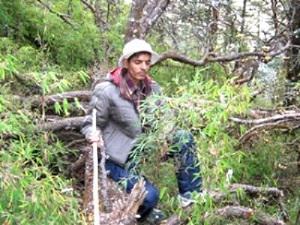Tulsi Ram Subedi
Other projects
29 Jan 2014
Raptor Migration Study and Conservation Camps Along the Migration Corridor and Wintering Ground in Nepal
25 Jan 2016
Understanding the Proximate Cause of Population Declines on the Population of Bearded Vulture (Gypaetus barbatus) in the Annapurna Range of Nepal
8 Jan 2020
Identification and Mitigation of the Main Threats Impacting Threatened Bearded Vultures in their Core Range of Nepal
The aim of the project is to identify and survey of potential red panda habitat and diffuse sensitization/outreach programmes to the target population for the conservation of red panda through community participation.

Fresh scat of Red panda found on field.
The native of eastern Himalayas in south Asian countries; red panda, has no reliable numbers exists for the total population in Nepal and is very threatened due to the fragmentation of its natural habitats and its specialized diet characters. Poaching for 'good luck charm' hats, fur clothing, intrusion by herders in the nesting and roosting places and illegal pet trade are some common threats to species for survival. In Dhorpatan Hunting Reserve threats are associated with catching pandas using snare, habitat loss by deforestation, overgrazing by livestock impacting ringal bamboo growth and intrusion by herders and dogs. Red panda is now listed as endangered species (IUCN 2007) and as a schedule I or top priority endangered species facing threat of extinction and protected by Government of Nepal by National Parks and Wildlife Conservation Act 1973.

Researcher observing the ringal bamboo eaten by red panda.
Due to the habitat specialization and its high sensitivity towards small change in the habitat red panda can be used as a focal species for conservation in the Himalayan temperate forests and an umbrella species for sub- alpine forests as well as an indicator of habitat quality.
The main aim of this project is to find out potential habitat, population status and diffuse conservation awareness among the locals to change their attitude for red panda conservation. To achieve the goals altitudinal line intercepts, Scat measurement and Paw print survey will be used following Sutherland 1996 and Yonzen 1989. The habitat of the red panda will be surveyed using plot less (Mueller- Dombois and Ellenberg 1974) and quadrate sampling method to access microhabitat characteristics. The conservation outreach programmes will be conducted for communities, herders, school teachers, students and local leaders.
It is expected that total population status and conservation threats of red panda will be identified and information on red panda distribution will be disseminated to the local communities/organizations, national level NGOs, INGOs and related governmental organizations for its participatory conservation actions. The conservation education to locals will help to discern the importance of wildlife species and their attitude towards red panda and other wildlife conservation will be changed by this project. Thus it will encourage the local to build civil society network for red panda conservation. The university post graduate students will be directly involved in field activities to transfer skills in next generation for the long term conservation, management and monitoring of red panda.